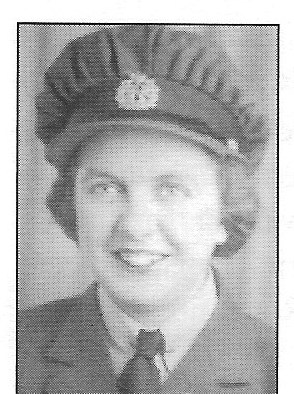
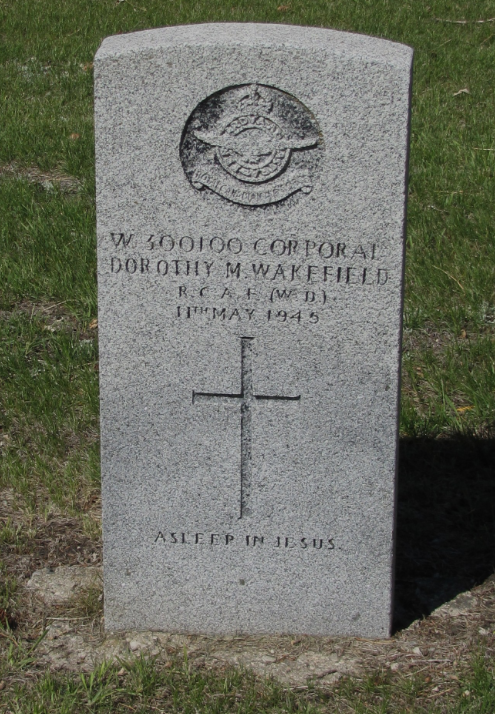
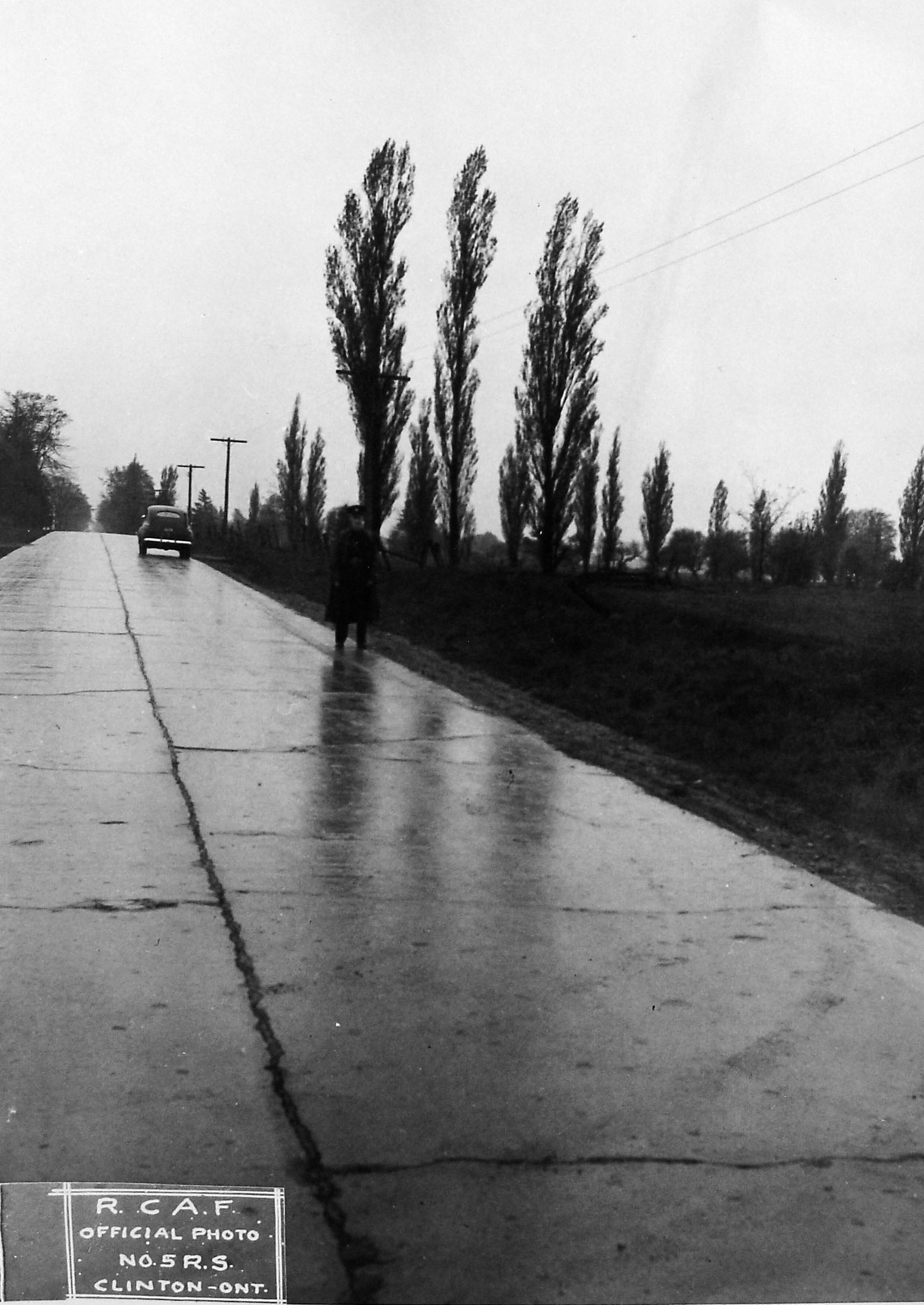
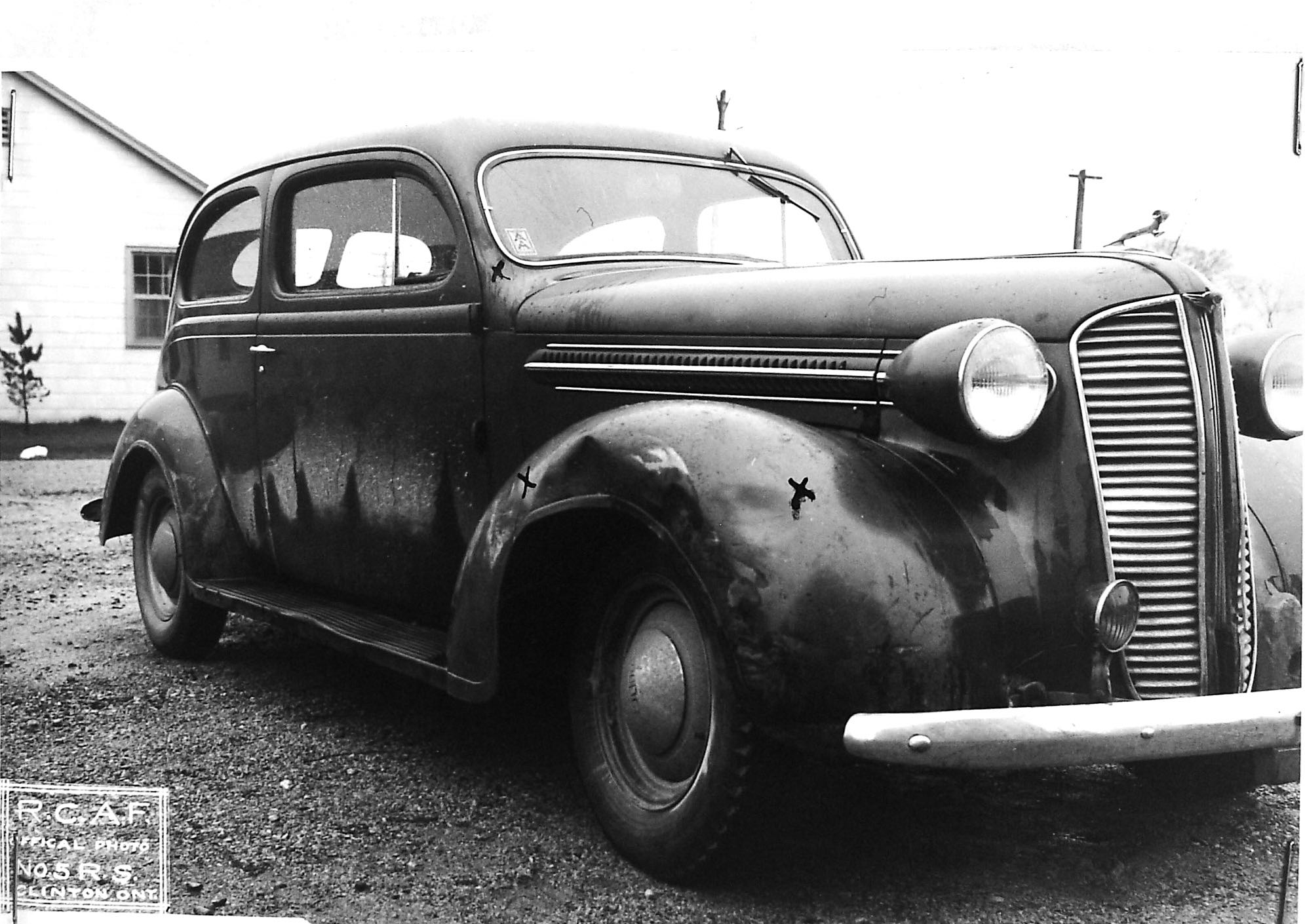
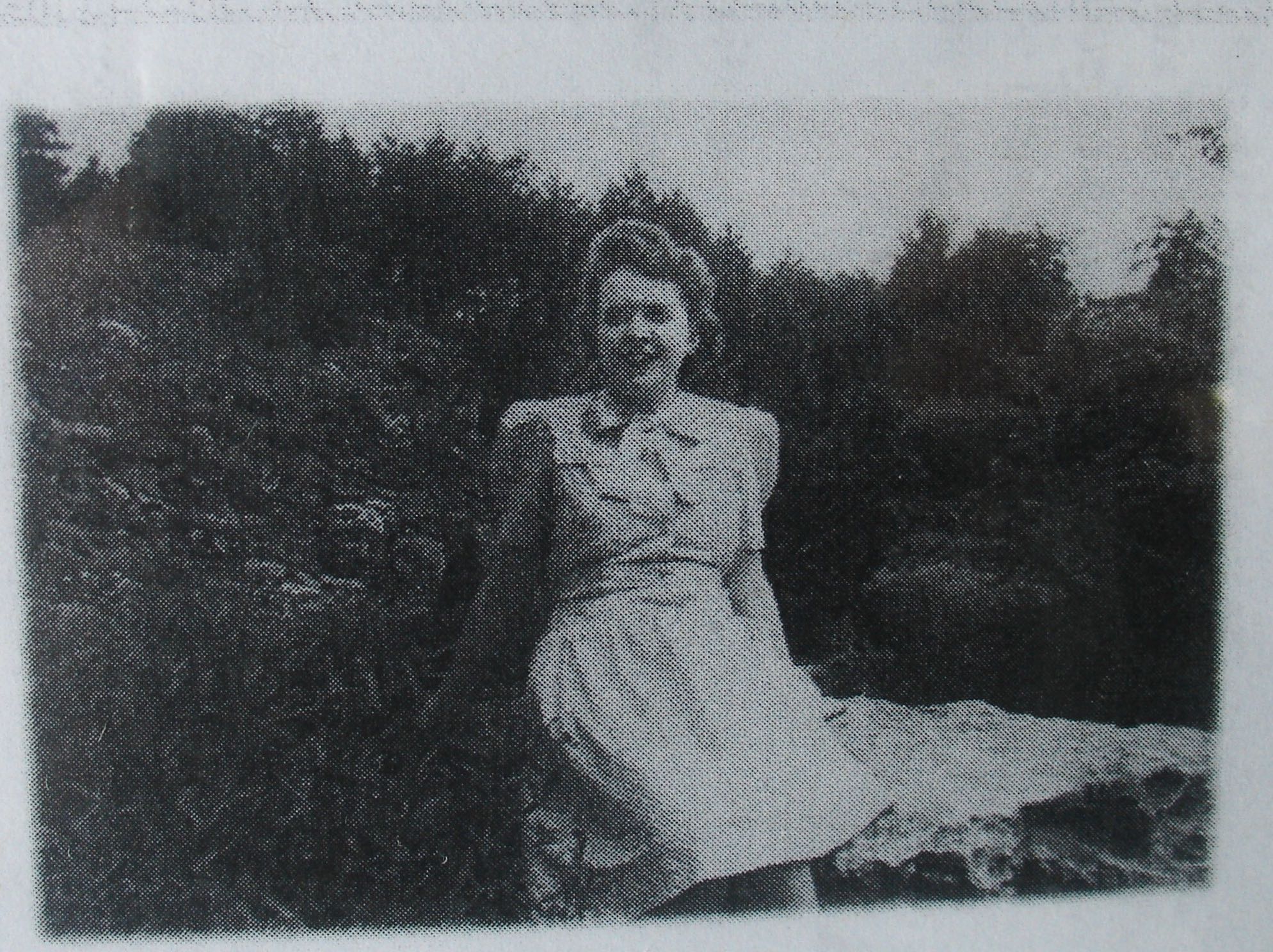

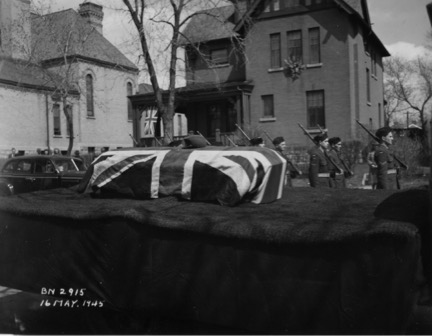
May 12, 1920 - May 11, 1945







Dorothy Maria Wakefield was the daughter of Walter and Ingred Reid (Cray) Wakefield of Forrest, Manitoba, located about 15 kilometres north of Brandon. (They later moved to Brandon.) Her parents were British born. She had seven brothers, aged 22 to 2: Gordon, Donald, George, Douglas, C. Ralph, Garth, and L. Blaine, with Gordon in the Canadian Army, plus three sisters, Mrs. Ethel Marling, Mrs. Gladys Nelson and I. Grace, aged 28 to 16 by 1945.
Dorothy enlisted in December 11, 1941 in Winnipeg. She had been a cook at 'the mental hospital' in Brandon, Manitoba.
Dorothy Wakefield was a cook, then a chef in the RCAF (WD). At the RCAF School of Cookery, February 14, 1942: "Ranked first in class of 24. Very neat, tidy, quick worker. Excellent previous experience. One of the outstanding trainees to attend this school. NCO calibre...ABOVE THE AVERAGE. Not suitable as instructor."
TRAINING AND POSTINGS:
Cpl Wakefield was admitted to Station Hospital at No. 10 SFTS, Dauphin, Manitoba, on March 15, 1942, remaining there until the 18th.
At No. 10 SFTS, she failed to attend a parade on August 12, 1942 and was confined to barracks for three days.
On June 8, 1944, at the No. 1 School of Cookery, Cpl Wakefield was assessed. "In general trade proficiency, Cpl Wakefield is considered slightly above average. Her knowledge and skill in baking are above average. She is a clean, quick worker and her products are consistently good. She has good organizing ability but is too young to be completely successful as a mess supervisor. As a Junior NCO, she is at least average. This NCO was interested in the course and worked energetically. She cooperated fully with mess personnel and was always reliable. Her academic work is above average. In trade proficiency, she is slightly above average. As a Junior NCO, her ability to organize and supervise the work of a shift is considered average."
During the evening of May 11, 1945, Cpl Dorothy Wakefield and LAW Isabel Davie, Hospital Assistant, employed in the Station Hospital, No. 5 Radio School, Clinton, Ontario, went for a bicycle ride, when Dorothy was struck by a car and killed. The Huron County Police, the Ontario Provincial Police investigated the accident, and an RCAF Court of Inquiry was held. The driver of the car and his passenger were held pending arrival of the civil police. Her bicycle did not sustain any damage.
The Coroner of the town of Clinton, County of Huron, John William Shaw, stated on May 12, 1945: "I visited and examined the body of the said Dorothy Wakefield, and learned from Miss Isabel Davie who was riding on a separate bicycle about 9:30 pm on No. 4 Highway when a car coming from behind, struck Dorothy Wakefield and killed her instantly. A car driven by George Cantlon [sic]was blinded by the light of a meeting car, did not see her in time, as she had no light on her bicycle. He passed first bicycle but at that moment, Dorothy bent over, put her foot on the road towards his car and was struck. William Flaxbard who was riding with Cantlon [sic] corroborated this statement. Miss Wakefield had her neck and skull fractured causing instant death. It was an accident where all parties were responsible. Cantlon [sic]said he was driving at 35 mph. Bicycles no lights, riding slowly. Glare of approaching car blinded. Upon these facts, I issued an order to bury the body."
Isabel Davie stated at the Court of Inquiry: "We went first to Clinton and then on towards Bayfield, and then it started to rain and we turned back to come through Clinton at approximately 2100 hours or perhaps a little earlier. We then started out from Clinton to the Station and we were proceeding south at about 2115 hours along the highway. Cpl Wakefield was in front of me and we were both riding along the right side of the pavement about 1 foot from the edge of the concrete. At this time, it was quite dark and neither of the bicycles had lights on them. As nearly as I can recollect, there was a reflector on the rear mudguard of my bicycle, but I do not think there was one on Cpl Wakefield's bicycle. When we had reached a point about 1/2 mile south of Clinton and travelling in the same way which I have previously described, I heard a car overtaking us and we were well over to the right hand side of the road. I did not bother to look around, believing he would have no difficulty in passing us. The car passed me, leaving plenty of room between us, but then it seemed to swerve sharply to the right and struck Cpl Wakefield just at the base of the skull on the left side of her head, with the part of the car immediately to the right of the windshield and behind the engine cowling, which I believe is sometimes called the corner post. The force of the impact did not appear to throw Cpl Wakefield any distance, as she continued on her bicycle for a moment or two, and then fell towards the right, almost in the same spot where she had been struck. At the time of the collision, I would estimate the speed of the car to be somewhere between 30 and 40 mph. After the impact, the car proceeded between 20 and 30 feet south on the road, and then stopped. As I was riding 4 feet behind Cpl Wakefield, I had to swerve sharply to the right and I stopped where she was lying on the shoulder of the road. I saw that she was injured, and called to the occupants of the car and the passenger in the car got out and came to where I was and I told him that Cpl Wakefield was injured and to help me carry her to the car. He then called to the driver to back the car up to where we were, and the passenger helped me to carry Cpl Wakefield into the car, and then we both got into the car and proceeded south along the highway. When I got into the car, I told the driver to take us to the hospital, assuming that he would know I meant the Station Hospital. However, we went a short distance south and the driver turned the car into a driveway, and evidently intended going back to the civilian hospital, and I told him that I thought we should go to the Station Hospital, and he then backed out of the driveway and proceeded to No. 5 RS and we took Cpl Wakefield to the hospital immediately. I do not remember seeing any car which approached Cpl Wakefield and me at the time of the accident or just around that time. It may be that there was a car that did pass us, but I am unable to say truthfully that I remember seeing it. Just prior to the accident occurring, Cpl Wakefield was riding about 4 feet in front of me and about 1 foot from the right edge of the pavement. She was not off her bicycle and was riding in a normal fashion. The rear wheel of her bicycle was not off the pavement, and she was travelling in a straight line parallel to the edge of the concrete. At the time of the accident, it was not raining, although it had been sprinkling a few drops of rain just a short time before. There was no mist or fog, although it was quite dark."
The passenger of the car, William Henry Flaxbard, aged 19, farmer, of Zurich, Ontario, employed by Mr. Fred Lawrence at Mitchell, Ontario said, "On May 11, 1945, I embarked as a gratuitous passenger in a 1937 Dodge car driven by George Cantelon. I never knew Mr. Cantelon before. I embarked in the front seat of this car in the town of Clinton. There were no other passengers in this car. We were proceeding on the highway leading towards the Air Force Station and were proceeding at a speed of about 36 to 37 miles per hour. Immediately prior to the accident, we were not talking to each other. Driving along in this manner, I saw another car approaching along the highway from the opposite direction. When the two cars were still about 800 feet apart, Cantelon dimmed his headlights but the other car never dimmed or lowered his lights. When the distance between the cars was reduced to about 100 feet, Cantelon removed his foot from the accelerator and the speed of our car began to diminish. Suddenly, I saw two girls on bicycles in front of us, the first one about 10 feet ahead of us and the other about six feet ahead of the first. These two cyclists were travelling in the same direction as Cantelon's car and were following each other. The cyclist near to us was riding at a distance of about one foot from the extreme edge side of the pavement. The bicycle of the other girl had the rear wheel off the pavement and the front wheel on the pavement. It appeared to me that the latter girl had one foot on the ground and was attempting to get onto the pavement from the gravel shoulder on her (and my) right side of the road. Her front wheel was facing toward the centre of the road. This was the relative position of the cyclists and our car when I first saw the former. At this time, the other car was still approaching us at the same speed as before and was still about 20-25 feet away from us. At this moment, Cantelon swerved towards the centre of the highway to avoid the cyclists, but as the other car came closer, Cantelon veered back towards the right side of the road and just as the two cars were passing each other, our car struck the cyclist furthest ahead. When we had gone about 35 feet after the impact, Cantelon applied his brakes and we stopped within 5 or 6 feet...we backed up and saw that one of the girls was injured. We took both girls into our car, advanced about 200 feet down the road and turned left into the first driveway in order to turn our car about with the intention of driving the injured girl to the hospital in Clinton. However, the other girl asked that we take her friend to the hospital at the Air Force Station so we merely backed out of the driveway and continued in the direction in which we were originally going and took the two girls to the Air Force Station. The other car never stopped and I do not know what kind of a car it was. All this occurred at about 9:15 pm and it was already quite dark out."
The third witness was the driver of the car, George Roy Melvin Cantelon, 20 years old, farmer, residing in Clinton, Ontario. He was working and living with his father, Roy Cantelon. "On May 11, 1945, I was driving the Dodge Coach, bearing license number 4-Z-674 (Ontario 1945), the property of my father. I was on my way from Clinton to Bayfield to visit some friends. I am in possession of Ontario Driver's License No. 521611. When I left my home that evening, I was along in the car, but as I was driving through the town of Clinton, I picked up a hitchhiker whom I afterwards found to be William Flaxbard. I left the town of Clinton at about 9 pm that evening and drove along the highway which leads to No. 5 RS, RCAF, Clinton, Ontario. It was dark but there was no rain or mist at the time. Flaxbard was riding in the front seat with me and we were proceeding at a speed of approximately 35 mph. I had my bright headlights on. When I was about a mile outside of Clinton, I saw another car approaching me from the opposite direction at a speed of about 60 mph, at a distance of about 600 feet. This car had its bright headlights on. I immediately dimmed my headlights when I noticed that the other car was not dimming his lights. I took my foot off the accelerator, as I was being blinded by his lights. When the two cars had almost met, I suddenly noticed two bicyclists in front of me, proceeding in the same direction as myself and in single file on my right hand side of the road. They were both riding about 1 1/2 to 2 feet from the from the extreme right hand edge of the pavement, and the cyclist furtherest ahead appeared to be hopping along with one foot on the bicycle and one foot on the ground. The latter appeared to be somewhat at an angle with the rear of her bicycle facing towards the right hand ditch and the front wheel towards the centre of the road. I am unable to state whether they bicycle which I struck was further from the right hand edge of the highway than the other one. When I first saw these cyclists, I was about 15-25 feet behind the rearmost of the two. I had not applied my brakes at all up to that time although I had reduced the speed of my car somewhat by having released the pressure from the accelerator. There were no lights whatever on either of the bicycles, although I afterwards found there was a reflector on the rear of the first bicycle but this reflector was ineffective due to the position of this bicycle. Because of the proximity of the other car, I was unable to take any evasive action and before I knew it, I had struck the bicycle furtherest ahead, with the right front fender of my car. I applied the brakes to my car and came to a stop and went to the assistance of the injured girl. The brakes on my father's car are in good condition except that in order to make them hold properly, it is sometimes necessary to pump the brake pedal a short distance first. However, on the evening in question, I could easily have stopped the car within ten feet with the brakes in the condition in which they were at the time, and at the speed at which I was then travelling. When the other car passed me, he was travelling at a speed of at least 60 mph, never dimmed his headlights, and never stopped, although he was on his side of the road at all times, he was fairly close to the centre of the highway. My father's car is insured against public liability and property damage with the Halifax Insurance Company....and Mr. Gordon Jewell, of Goderich, Ontario, is our agent. The highway follows a straight line for 1/2 mile in north and south from the scene of the accident." George Cantelon identified the photographs of his father's car, noting the dents marked with an x.
The fourth witness was F/O J. E. Galloway, Wireless Officer, No. 5 Radio School, Clinton, Ontario. "On May 11, 1945, at about 2145 hours, I was walking southward on No. 4 Highway from the town of Clinton towards No. 5 R.S. I was walking on the left-hand or east side of the roadway, when a car proceeding northward passed me at a speed in excess of 50 mph. I did not notice what lights he had on, but he did have some lights on. As he passed me, I turned about to watch him proceed along the highway. While I was thus watching him, and when he had reached a point about a 1/4 mile north of where I was standing, he passed another car proceeding southward. Just at about the time these two cars were passing each other, I heard the screech of brakes and noticed that the southbound car stopped whilst the northbound car proceeded on its way. I am not able to judge the speed of the southbound car when the two cars passed each other. The southbound car then appeared to back up a short distance, come forward again to drive into a driveway leading eastward, but then backed out again to face southward again, and proceeded on his way in the direction of No. 5 R. S. I didn't know what happened at the time, but when I arrived at the Station, I learned that an accident had occurred involving Cpl Wakefield and it was obvious to me that this occurred at the time when I saw the two cars passing me along the highway as above mentioned. The paved portion of the highway at the place where the collision occurred is 20 feet wide. It was not raining at that time nor was there any mist or fog, although night had fallen. The highway is perfectly straight for a distance of at least 1/2 mile in either direction at the scene of the accident. The road is perfectly level for at least 1/2 miles northwards of the scene of the accident."
The fifth witness was F/L Wilfred Grant Webster, Medical Officer at No. 4 RS, Clinton, Ontario. "On May 11, 1945,at about 2145 hours, W300100 Cpl Wakefield, D. M. was brought into the Station Hospital and I immediately examined her. I found that she had a fracture of the base of the skull and had died instantly as a result thereof."
The sixth witness, F/O A. C. MacLean, P.T. and D. Officer at No. 5 Radio School stated, "Bicycle riding does not form part of the Physical Fitness programme at No. 5 R. S. and is not accepted for credit for Physical Fitness periods."
In the disposition: "There was no inquest and no charges were laid against the driver of the automobile." The Findings: "That the said accident was due to the common fault of the said Cpl Wakefield in cycling on a public highway after dark without any lights showing and that of the said George Cantelon in not having reduced the speed of his car when he found himself blinded by the lights of the oncoming car."
In the list of Dorothy's personal effects, the following was noted: clothing, one doll, Chinese checkers, shoes, skates and boots, make up, an alarm clock, jewellery, a swim suit, stationery, toiletries, a diary, birthday and autograph books, an electric iron, and one bicycle.
On July 23, 1945, Mr. and Mrs. Wakefield wrote to the RCAF Estates Branch. "I wrote you on Saturday, asking to please forward my daughter's bicycle home to us. Well, we still want the bicycle sent home after I got home. I was sorry I hadn't stated that in my letter that if the bicycle was in a damaged condition, I would think it should be repaired before being sent home and that George Cantelon should pay for having it repaired. As for all if he hadn't of killed my daughter, she would still be alive. Her life was worth a lot to us. I would also like to mention here that I have never had any word from George Centelon. I have been waiting to hear what they did to him. I expected I would be hearing from the Air Force what was being done as they would know all particulars about the accident."
On September 17, 1945, the RCAF's memo: "Please advise disposition of one bicycle which was the property of the late airwoman. A request for same has been received from the above mention's airwoman's parents." In another letter, dated September 29, 1945: "May the above deceased's bicycle be sent by Express, prepaid, direct to her mother, Mrs. Ingred R. Wakefield, General Delivery, Brandon, Manitoba, please. May suitable receipt be obtained from Mrs. Wakefield and forwarded to this Branch." Dorothy's bicycle arrived in Brandon, with a receipt signed by her mother. A date stamp of October 26, 1945, Ottawa on the receipt was found in Dorothy's files in Ottawa.
On December 3, 1945, Mrs. Wakefield received a letter from the Estates Branch, Ottawa. "We have received direct from Air Tranposrt at our request a cheque payable to your order in the amount of $522.53...As previously pointed out, your daughter, Miss Grace Wakefield, is entitled under the terms of the Will to receive the sum of $144.35. However, as she is under 21, regulations do not permit us to effect distribution in favour of a minor beneficiary, excepting through his or her legal guardian. This amount has been paid in trust to you for her benefit. The balance of $378.18 has been paid to you as residuary beneficiary under the Will."
In Dorothy's will, she stated that to her sister, Grace, she was to receive the balance of her bank account. Her sister, Gladys, was to get her trunk and contents, and her sister, Mrs. Ken Marling, was to get her table lamp. Mrs. Wakefield was given her remaining personal belongings.
In the Station Diary, on May 13, 1945, this was noted: "The station has not completely recovered from its shock of the news of the death of Cpl. D. M. Wakefield, W300100, who was killed in an accident on the highway between Clinton and the station. She was riding a bicycle when she was run down by a motorist who had been temporarily blinded by the lights of an oncoming car. This occurred on the night of Friday, the 11th of May. A Memorial Service was held in the Funeral Parlour in Clinton prior to the shipment of the body to Brandon, Manitoba at the request of next-of-kin. F/L Dawson, S/O Cottet, F/O Leggett, and S/O Glenn attended this service along with many airmen and WD's. S/O Glenn accompanied the body to Brandon." Cpl Dorothy Maria Wakefield was buried in the Brandon Cemetery.
LINKS: